#National Register of HIstoric Places
Text

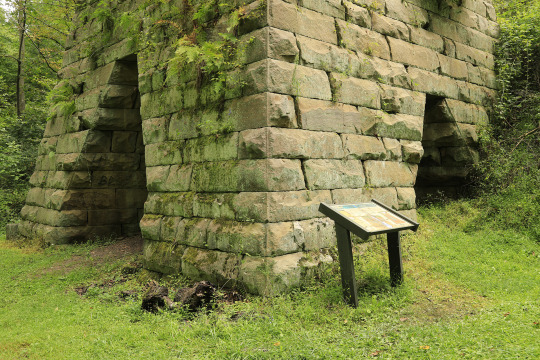


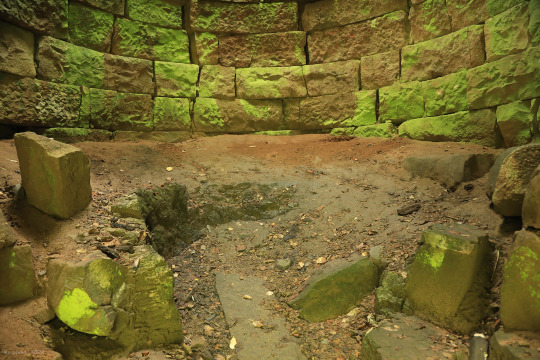
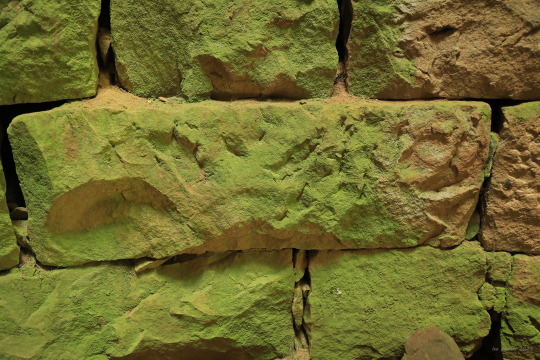
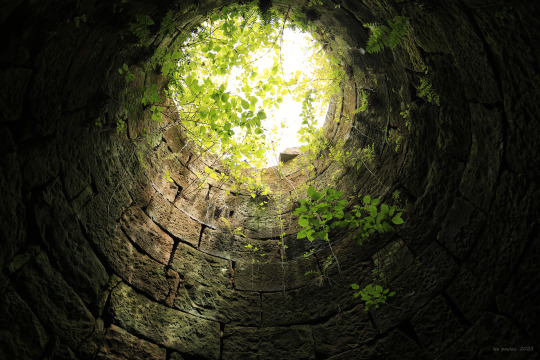

The Virginia iron furnace near Albright, West Virginia is one of a handful of water-powered blast furnaces still standing; they were constructed to smelt pig iron, a key ingredient in steel, in the early days of America's industrial area. Iron ore and limestone from the local mountains were poured onto burning charcoal from the top of the furnace, and molten iron ran out the bottom. The temperature of the charcoal was maintained by a bellows powered by a waterwheel, which was turned by water diverted from adjacent Muddy Creek. Built in 1854, the furnace ran until the end of the 19th Century, and was eventually acquired and preserved by the Daughters of the American Revolution. The structure has since been added to the National Register of Historic Places. In addition to its historical significance and beautiful setting next to Muddy Creek, the furnace also apparently serves as a clandestine meeting place for those seeking a more personal form of recreation (seriously, people will do it anywhere).
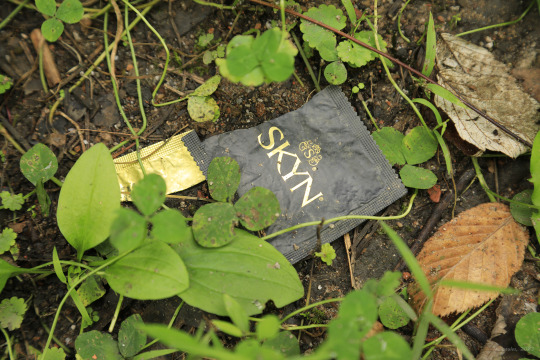
#appalachia#vandalia#west virginia#iron furnace#iron ore#pig iron#preston county#muddy creek#cheat river#industrial history#human history#smelting#virginia iron furnace#national register of historic places#daughters of the american revolution
74 notes
·
View notes
Text
Ga. islanders vow to keep fighting change favoring rich buyers

DARIEN, Ga. - Descendants of enslaved people living on a Georgia island vowed to keep fighting after county commissioners voted to double the maximum size of homes allowed in their tiny enclave.
Residents fear the move will accelerate the decline of one of the South’s few surviving Gullah-Geechee communities.
An aspect of the ordinance that residents take issue with is the fact that it erases a clause about protecting the island’s indigenous history.
During public meetings leading up to the vote, the zoning board proposed changes to the ordinance of lowering the newly allowed home size and removing talk of golf courses being added to the island.
Black residents of the Hogg Hummock community on Sapelo Island and their supporters packed a meeting of McIntosh County’s elected commissioners to oppose zoning changes that residents say favor wealthy buyers and will lead to tax increases that could pressure them to sell their land.
ISLAND’S HERITAGE
Gullah-Geechee communities like Hogg Hummock are scattered along the Southeast coast from North Carolina to Florida, where they have endured since their enslaved ancestors were freed by the Civil War. Scholars say these people long separated from the mainland retained much of their African heritage, from their unique dialect to skills and crafts such as cast-net fishing and weaving baskets.
Regardless, commissioners voted 3-2 to weaken zoning restrictions the county adopted nearly three decades ago with the stated intent to help Hogg Hummock’s 30 to 50 residents hold on to their land.
Yolanda Grovner, 54, of Atlanta said she has long planned to retire on land her father, an island native, owns in Hogg Hummock. She left the county courthouse Tuesday night wondering if that will ever happen.
“It’s going to be very, very difficult,” Grovner said. She added: “I think this is their way of pushing residents off the island.”
Hogg Hummock is one of just a few surviving communities in the South of people known as Gullah, or Geechee, in Georgia, whose ancestors worked island slave plantations.
MORE | Mom in Grovetown calls cops on U.S. energy secretary’s staff
Fights with the local government are nothing new to residents and landowners. Dozens successfully appealed staggering property tax hikes in 2012, and residents spent years fighting the county in federal court for basic services such as firefighting equipment and trash collection before county officials settled last year.
“We’re still fighting all the time,” said Maurice Bailey, a Hogg Hummock native whose mother, Cornelia Bailey, was a celebrated storyteller and one of Sapelo Island’s most prominent voices before her death in 2017. “They’re not going to stop. The people moving in don’t respect us as people. They love our food, they love our culture. But they don’t love us.”
Merden Hall, who asked not to be on camera, has lived on Sapelo his whole life. He says he’s worried about the sizes of homes now allowed on the island.
“I’m not comfortable with this. They approved the 3,000 square feet, that’s the only thing I disapprove of, because that’s going to raise property taxes,” he said.
Hogg Hummock’s population has been shrinking in recent decades, and some families have sold their land to outsiders who built vacation homes. New construction has caused tension over how large those homes can be.
Commissioners on Tuesday raised the maximum size of a home in Hogg Hummock to 3,000 square feet of total enclosed space. The previous limit was 1,400 square feet of heated and air-conditioned space.
Commissioner Davis Poole, who supported loosening the size restriction, said it would allow “a modest home enabling a whole family to stay under one roof.”
“The commissioners are not out to destroy the Gullah-Geechee culture or erase the history of Sapelo,” Poole said. “We’re not out to make more money for the county.”
Commission Chairman David Stevens, who said he’s been visiting Sapelo Island since the 1980s, blamed Hogg Hummock’s changing landscape on native owners who sold their land.
“I don’t need anybody to lecture me on the culture of Sapelo Island,” Stevens said, adding: “If you don’t want these outsiders, if you don’t want these new homes being built ... don’t sell your land.”
County officials have argued that size restrictions based on heated and cooled spaced proved impossible to enforce. County attorney Adam Poppell said more than a dozen homes in Hogg Hummock appeared to violate the limits, and in some cases homeowners refused to open their doors to inspectors.
Hogg Hummock landowner Richard Banks equated that to the county letting lawbreakers make the rules.
“If everybody wants to exceed the speed limit, should we increase the speed limits for all the speeders?” Banks said.
Hogg Hummock residents said they were blindsided when the county unveiled its proposed zoning changes on Aug. 16. Commissioners in July had approved sweeping zoning changes throughout McIntosh County, but had left Hogg Hummock alone.
Commissioner Roger Lotson, the only Black member of the county commission, voted against the changes and warned his colleagues that he fears they will end up back in court for rushing them.
Two attorneys from the Southern Poverty Law Center sat in the front row. Attorney Anjana Joshi said they had “due process and equal protection concerns” about the way the zoning ordinance was amended.
“In our view, this was not done correctly,” said Joshi, who added: “We’re just getting started.”
Located about 60 miles south of Savannah, Sapelo Island remains separated from the mainland and reachable only by boat. Since 1976, the state of Georgia has owned most of its 30 square miles of largely unspoiled wilderness. Hogg Hummock, also known as Hog Hammock, sits on less than a square mile.
Hogg Hummock earned a place in 1996 on the National Register of Historic Places, the official list of the United States’ treasured historic sites. But for protections to preserve the community, residents depend on the local government in McIntosh County, where 65% of the 11,100 residents are white.
#Ga. islanders vow to keep fighting change favoring rich buyers#Gullah Geechee#Gullah Land#sapelo#sapelo island#Freedmen Lands#Stolen Lands#nrohp#national register of historic places
59 notes
·
View notes
Text

Destinations: Grand Central Station (New York City, NY)
Selden paused in surprise. In the afternoon rush of the Grand Central Station his eyes had been refreshed.
#grand central terminal#grand central station#Grand Central#new york#new york city#architecture#new york aesthetic#New York moodboard#architecture aesthetic#Architecture moodboard#Destinations#travel destinations#Destination aesthetic#Destination moodboard#moodboard#aesthetic#nyc#nyc aesthetic#nyc architecture#nyc style#nyc living#nyc moodboard#public building#national register of historic places#beaux arts#edith wharton
30 notes
·
View notes
Text

Windows
What do you think about my pic?
#Maryhill Stonehenge#Maryhill#Washington#Klickitat County#Stonehenge Memorial#travel#original photography#vacation#tourist attraction#landmark#cityscape#landscape#USA#summer 2023#World War One Memorial#photo of the day#concrete#flora#nature#grass#hill#free admission#What do you think about my pic?#Sam Hill#National Register of Historic Places#Pacific Northwest#Columbia River Gorge#Columbia River
10 notes
·
View notes
Text

The Mindoro Cut, between Mindoro and West Salem in La Crosse County, is the second deepest cut made by hand in the Western Hemisphere and the oldest functional cut that has not been improved. Work on the cut began in 1907 and was completed in 1908. This site is listed on National Register of Historic Places.
9 notes
·
View notes
Text

The Irish Hills Towers are two wooden observation towers located at 8433 West U.S. Highway 12 in Cambridge Township, Lenawee County, Michigan, in the Irish Hills region. They were added to the National Register of Historic Places on May 2, 2007.
Photo By Matt Callow
#Irish Hills Towers#wooden#observation towers#Cambridge Township#Michigan#US#National Register of Historic Places#black and white#photography#spooky#1924#old
37 notes
·
View notes
Photo

1943 William Allen and W. George Lutzi, Burbank City Hall, Burbank, California. Art Deco Architecture.
National Register of Historic Places
#1943#architecture#art deco#art deco architecture#william allen#w. george lutzi#burbank city hall#burbank#historic places#california#National Register of Historic Places#allen#lutzi
31 notes
·
View notes
Text

Summit Terrace,the home of American novelist,F.Scott Fitzgerald,author of the glittzy,decadent novels,The Great Gatsby,and Tender is the Night.
Summit Terrace,599 Summit Avenue,Saint Paul,Minnesota,55102,USA (NRHP)
#F.Scott Fitzgerald#Literary Residences#Summit Terrace#Saint Paul#Minnesota#USA#National Register of Historic Places
7 notes
·
View notes
Text
Little Tokyo Historic District, Los Angeles









2 notes
·
View notes
Text
Lafayette Cemeteries No. 1 & 2-New Orleans, Louisiana
Lafayette Cemeteries No. 1 and No. 2 are located in the Garden District part of New Orleans. Number 1 was the first municipal cemetery, and it was laid out in 1832. There are over 7,000 burials in 1,100 different tombs in a one-city block. Lafayette No. 1 is currently closed to the public as the city continues to stabilize the tombs and roadways. (These photos were taken in 2017.)
One of the…

View On WordPress
10 notes
·
View notes
Text

3 notes
·
View notes
Text
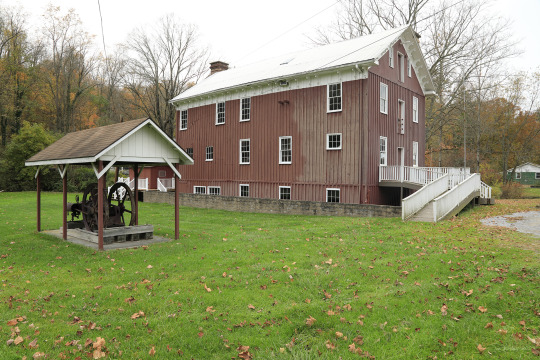

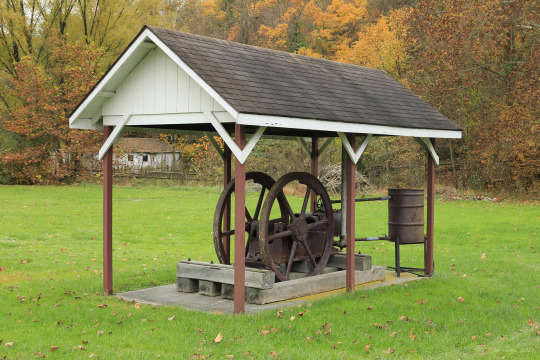


The historic Easton Roller Mill outside Morgantown went into operation in the mid-1800s to mill and grind a variety of grains, including wheat, rye, oats and buckwheat, as well as corn. The grist mill was originally equipped for stone grinding, which used heavy burr stones (bottom photo) driven by a coal-powered steam engine to mill and grind the grains into highly-refined flour and the corn into cornmeal. The roller mill prospered well into the 1930s. Today, the mill is owned by the Monongalia Historical Society, which conducts regular tours, and is on the National Register of Historic Places.

#appalachia#vandalia#west virginia#fall#easton roller mill#morgantown#monongalia county#monongalia historical society#grist mill#roller mill#national register of historic places
22 notes
·
View notes
Text


Wreck of The Mary D. Hume - May 2018
Gold Beach, Oregon
#oregon#the great pnw#pnw#original photography#the coast#the old west#oregon coast#gold beach#photographers on tumblr#rogue river#shipwreck#national register of historic places
21 notes
·
View notes
Text

The J.D. McDonald House is a historic house in Fremont, Nebraska. It was built in 1888 for J.D. McDonald, a Canadian-born railroad contractor who founded the Fremont Manufacturing Company and served on the board of directors of the Fremont National Bank. He hired M.A. Ecker to design it in the Queen Anne and Romanesque Revival architectural styles. It has been listed on the National Register of Historic Places since December 10, 1980
#fremont nebraska#nebraska#united states#usa#national register of historic places#historic#history#jd mcdonald#houses#architecture design#residential architects#fremont national bankt#canada#queen anne style#romanesque revival#design#artists on tumblr
2 notes
·
View notes
Text













The Contemporary Jewish Museum’s main building is the former Pacific Gas & Electric Jessie Street Substation, which was originally built in 1881 and was rebuilt in 1907 by Willis Polk after the 1906 San Francisco earthquake. The building was listed on the National Register of Historic Places on September 6, 1974.
#Contemporary Jewish Museum#Pacific Gas & Electric Jessie Street Substation#Willis Polk#National Register of Historic Places#Daniel Libeskind#6 September 1974#USA#summer 2017#travel#original photography#vacation#tourist attraction#landmark#architecture#cityscape#California#San Francisco#CJM#50th anniversary#US history
2 notes
·
View notes
Text

New on the National Register of Historic Places: The Church of the Incarnation, 3801 Pleasant Ave., Minneapolis
The Church of the Incarnation, in South Minneapolis, was designed by Emmanuel Louis Masqueray and completed in 1918. The brick and stone church (built by the same company that built the Foshay Tower and St. Mary’s Basilica, among other landmark buildings) combines Italian Renaissance and Romanesque Revival styles. It is notable for its ornate nave and chancel, which feature barrel-vaulted and semi-dome wood ceilings, stained glass windows, a marble platform and altar, side aisles and side chapels, and stone statues and altars. The rectory, built in 1913, is connected to the church via a tiled walkway built in 1932.
On March 9, 2022, portions of the church were damaged in an early morning fire. The church re-opened for services on October 2, 2022, after months of restoration work.
The Church of the Incarnation was listed on the National Register of Historic Places January 11, 2022. See the nomination documents here.
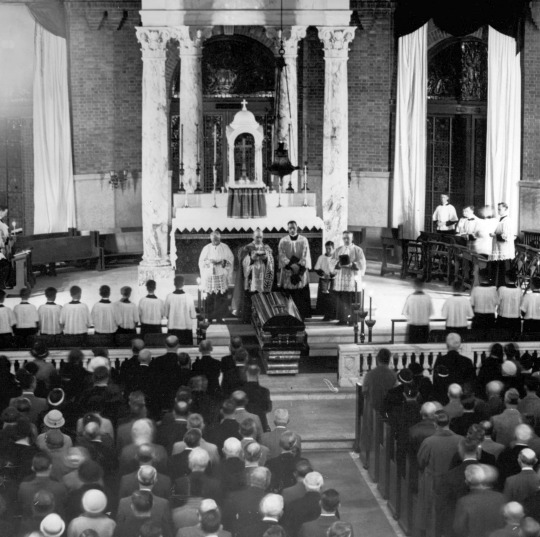
Photographs and building permit index card from the Hennepin County Library Digital Collections.
#minneapolis#Minnesota#national register of historic places#historic buildings#historic landmark#churches#Catholic churches#Church of the Incarnation
25 notes
·
View notes